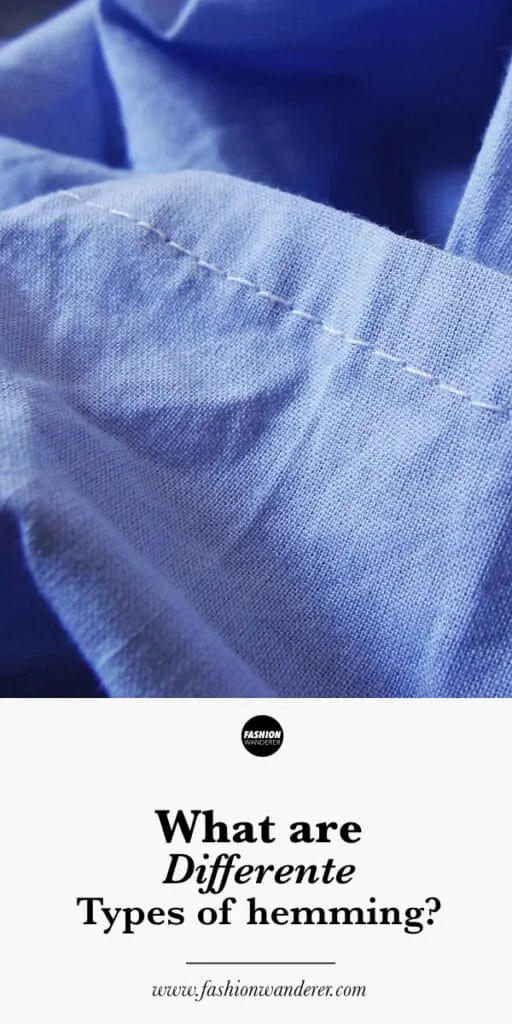Hemming a garment is the final stage of the sewing process. It helps to avoid from fraying the cut edges and also provides aesthetics depending on the type of hemming you are using.
Whether you are sewing knit or woven material, understanding different types of hemming and applying correct finishing touches is important.
What are the different types of hemming? The main types of hemming are double fold hem, narrow rolled hem, bias tape hem, blind hem, and zigzag or overlock hem. These hems are easily achievable with a sewing machine or by hand stitches on any clothes.
Based on the style and look that you are going for, hemming can vary from one design to another.
A hem is a finishing method of a garment where the edge of a cloth piece is first folded and then sewn. This is done to avoid unraveling the fabric.
This adjusts the length of the garment piece like the bottom of a sleeve end, dress or pant legs. Sewing hems depends on the fabric you are hemming and sewing.
In this article, you will learn differenttypes of hemmingto choose from and what is difference between seam and hem in sewing terms. Answered below are frequently asked questions about the types of hemming frequently used in sewing.
What type of stitch is used for hemming?
The type of stitch used for hemming is based on the fabric, type of garment, and the type of hem you select for the garment. The best hemming stitch for visible is a straight stitch, and for an invisible look select a blind hemstitch.
For the majority of hems, a straight stitch is used on a sewing machine unless you are considering to sew a blind hem with running hand stitch. The other hem stitches that are hand-sewn are catch stitch, blind stitch, pick stitch, and slip stitch.
Amongst the hem stitches, the best is the blind hemstitch, which is a variation of a zigzag stitch. It will catch the edge marginally that is folded onto the garment fabric, and this stitch is hardly visible as the stitching line is covered or blinded.
What is the difference between hem and seam?
When reading a sewing pattern and instructions, you will see the word hem and seam often used.
The primary difference between seam and hem is that a seam joins two or more fabric pieces while a hem is an edge of a fabric piece that is folded to itself.
Some differences between hem and seam are as follows:
- Hems and seams, both are finishing types and confuse several beginners in sewing.
- Able to finish a hem in many ways like facing, folding, and stitching, attaching a decorative trim and binding while seaming is edging the fabric with one cloth.
- Sewing seams involve two fabrics when a hem is with one fabric.
- Hems are used primarily for edge reinforcement, rough edges, improve the appearance, and hide burrs. While a seam is used to join two fabrics.
- Hem prevents over fraying of fabrics, but to finish a seam requires the fabric edges to be bound and finished.
What are the different types of hems?
Different types of hems offer a clean finished edge to a garment that makes a durable and store-bought finish.
Generally, the hem allowance is ranging from ¼” to 2”, which may vary from garment to garment. The smaller allowance the less bulkier than the wider width.
Follow the sewing instruction to select the perfect hem method to use from listed below.
10 different types of hems include:
- Single Fold Hem: Made by one time folding the fabric back and straight stitch in place. The cut edge or overlocked edge will be exposed on the backside of the fabric. Most often used on the garment where you won’t see the inside of the finished project.
- Double Fold Hem: Most widely used hem where the fabric is double folded, which aids to enclose the fabric’s raw edge. This type of hem may not be easy for bulky and heavy fabrics. Also, can be topstitched on the machine or slip stitch by hand for a super clean finish.
- Rolled Hem: This hem is hand-sewn or machine-sewn and done on lightweight fabric. You can sew the majority of fine silk scarves using a rolled hem that is less than ⅛” width. It is known for being the most expensive hem and used in high-end clothes.
- Blind Hem: It is invisible after sewing, hence called a blind hem. It is done with a blind hem machine foot. This hem is great for garment that requires weighted hem on skirt, jacket, pants or coats to give a nice tailored look, however a blind hem is not suitable for casual pieces.
- Bias Tape Hem: This hem type is terrific for thicker fabrics because a double hem or rolled hem can add bulk to the fabric. A single-fold bias hem is the most common hem used for the majority of fabrics.
- Pin Hem: Identical to a rolled hem, but it is very fine that resembles as narrow as a pin. It is generally sewn on fabrics like chiffon and lightweight cotton, and is a great option for a circle skirt. It can get tricky to double or single hem over 5mm or just over 3/16”, however best to use a 1.5 cm or 2 cm (½” or ¾”) seam allowances.
- Zigzag or Overlocked Hem: If you combine regular machine and serger machine, you get the zigzag or overlocked hem. These hems are terrific for the majority of the fabrics, and are great for hard-to-press and bulky fabrics along with sewing curved edges.
- Faced Hem:Known as false hem, which provides a professional finish for clothing. It is hand-sewn and drafted such that it complements the hem shape similar to sewing facing on the garment around a neckline. A faced hem is another piece of fabric instead of rolling on a hem allowance.
- Piped Hem:This is a hem type that adds detail to the hem, mostly used in pajamas shirts. Use bias tape binding to insert between the edge to create flat look or with cord insertion gives a 3D look. To secure the hem, use folded cuff to clean finish the piping inset.
- Bound Hem: This is the easiest hem to create by sewing a binding. This bound hem is sewn along the hem allowance to cover and enclose the fabric raw edge.

Hemming Types: Final Thoughts
Different types of hemming can be done depending on what fabric you are using. Hemming provides a nice finished edge to a fabric. It prevents over fraying of fabrics and rolls onto itself.
There are 5 types of hemming method that are widely used in sewing garments: double fold hem, narrow rolled hem, bias tape hem, blind hem, zigzag or overlocked hem. Depending on the style of garment, special finishes may be required to accomplish the professional look.
One of the most commonly used hems in the sewing pattern is the double fold hem.
Simply double fold the desired width and press prior to sewing to help you get even an even hemline. Stitch closely to the folded edge with straight stitch.
If you are sewing lightweight fabric, a narrow rolled hem is ideal solution, especially on blouses or draped circular dresses.
Use ⅛” to ¼” by double fold and press to stitch close to the top edge. You may use a special sewing machine foot to create this narrow hem as well.
On the other side, if the fabric is heavyweight and needs more attention, using a bias tape hem method is recommended. It will solve bulky hem and create clean one stitch line on the right side of the garment.
Place right side together and slide the bias tape and stitch down ¼” (6mm) from the raw edge.
For sturdy and high-end garments, blinds hem is an excellent choice. It is invisible from the right side of the fabric, and works best on wide straight hems on the bottom of pants or skirts.
Lastly, zigzag or overlocked hem require a sewing machine and serger to complete this finish. On most store-bought clothes, you will see this hem.
Simply overlock the cut edges and press it by the suggested hem allowance. Stitch around on top to finish the hem.
These standard types of hemming are achievable either by hand-sewing or with a sewing machine. Determine what garment you are sewing and type of fabric being used to figure out the best hemming for the design.
